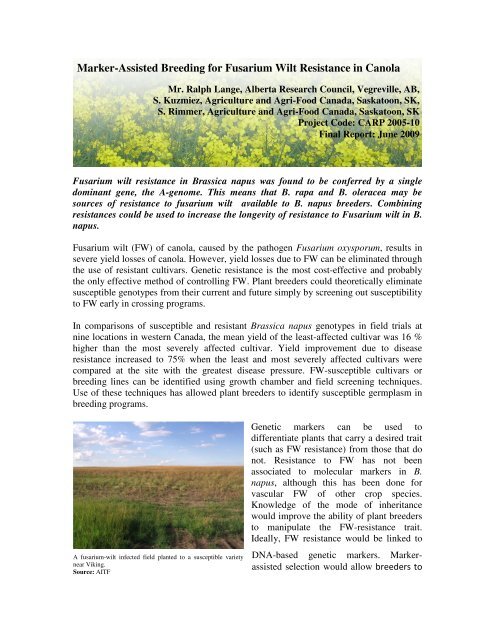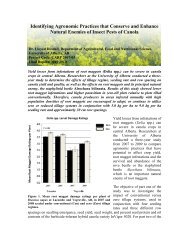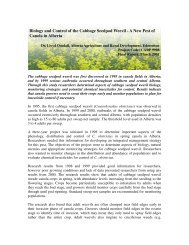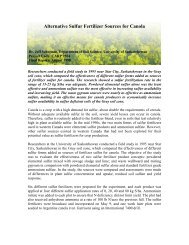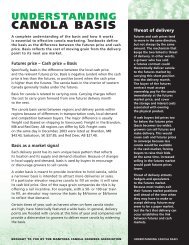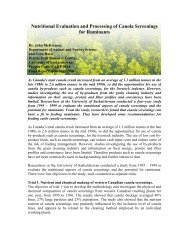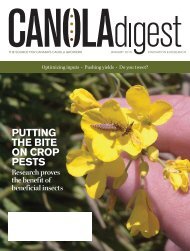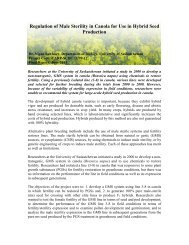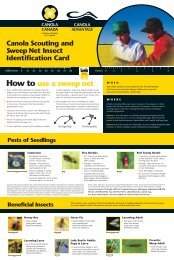Marker-Assisted Breeding for Fusarium Wilt ... - SaskCanola
Marker-Assisted Breeding for Fusarium Wilt ... - SaskCanola
Marker-Assisted Breeding for Fusarium Wilt ... - SaskCanola
You also want an ePaper? Increase the reach of your titles
YUMPU automatically turns print PDFs into web optimized ePapers that Google loves.
<strong>Marker</strong>-<strong>Assisted</strong> <strong>Breeding</strong> <strong>for</strong> <strong>Fusarium</strong> <strong>Wilt</strong> Resistance in Canola<br />
Mr. Ralph Lange, Alberta Research Council, Vegreville, AB,<br />
S. Kuzmiez, Agriculture and Agri-Food Canada, Saskatoon, SK,<br />
S. Rimmer, Agriculture and Agri-Food Canada, Saskatoon, SK<br />
Project Code: CARP 2005-10<br />
Final Report: June 2009<br />
<strong>Fusarium</strong> wilt resistance in Brassica napus was found to be conferred by a single<br />
dominant gene, the A-genome. This means that B. rapa and B. oleracea may be<br />
sources of resistance to fusarium wilt available to B. napus breeders. Combining<br />
resistances could be used to increase the longevity of resistance to <strong>Fusarium</strong> wilt in B.<br />
napus.<br />
<strong>Fusarium</strong> wilt (FW) of canola, caused by the pathogen <strong>Fusarium</strong> oxysporum, results in<br />
severe yield losses of canola. However, yield losses due to FW can be eliminated through<br />
the use of resistant cultivars. Genetic resistance is the most cost-effective and probably<br />
the only effective method of controlling FW. Plant breeders could theoretically eliminate<br />
susceptible genotypes from their current and future simply by screening out susceptibility<br />
to FW early in crossing programs.<br />
In comparisons of susceptible and resistant Brassica napus genotypes in field trials at<br />
nine locations in western Canada, the mean yield of the least-affected cultivar was 16 %<br />
higher than the most severely affected cultivar. Yield improvement due to disease<br />
resistance increased to 75% when the least and most severely affected cultivars were<br />
compared at the site with the greatest disease pressure. FW-susceptible cultivars or<br />
breeding lines can be identified using growth chamber and field screening techniques.<br />
Use of these techniques has allowed plant breeders to identify susceptible germplasm in<br />
breeding programs.<br />
A fusarium-wilt infected field planted to a susceptible variety<br />
near Viking.<br />
Source: AITF<br />
Genetic markers can be used to<br />
differentiate plants that carry a desired trait<br />
(such as FW resistance) from those that do<br />
not. Resistance to FW has not been<br />
associated to molecular markers in B.<br />
napus, although this has been done <strong>for</strong><br />
vascular FW of other crop species.<br />
Knowledge of the mode of inheritance<br />
would improve the ability of plant breeders<br />
to manipulate the FW-resistance trait.<br />
Ideally, FW resistance would be linked to<br />
DNA-based genetic markers. <strong>Marker</strong>assisted<br />
selection would allow breeders to
directly infer the genotype of very young plants, and avoid time delays caused by<br />
phenotype testing, and simultaneously avoid confounding effects of genotype x<br />
environment interactions.<br />
The objectives of this project were to identify and characterize the mode of inheritance of<br />
the FW-resistant phenotype in B. napus, to determine the number of genes associated<br />
with resistance and to identify microsatellite markers that are linked with those genes.<br />
Phenotype tests of the parental genotypes confirmed that SP Banner and DH12075 were<br />
resistant, and Canterra 1604 was susceptible to FW, confirming that subsequently-derived<br />
mapping populations were the progeny of crosses between resistant and susceptible<br />
plants.<br />
Segregation between F3 lines from<br />
reciprocal matings fit 3:1<br />
(Resistant:susceptible) segregation ratios<br />
individually and when combined,<br />
suggesting that resistance in B. napus cv.<br />
DH12075 is controlled by a single<br />
dominant gene <strong>for</strong> resistance to FW.<br />
Assessment of the A-genome indicated that<br />
microsatellite markers sR0404 and sR9448<br />
were associated with the resistant<br />
phenotype. On this basis, FW-resistance in<br />
B. napus was associated with a single<br />
locus mapping to A-3 linkage group.<br />
Genetic analysis of FW resistance in B.<br />
In comparison, a resistant variety field located immediately<br />
adjacent to the affected field near Viking.<br />
Source: AITF<br />
napus has not been conducted previously, but resistance has been associated with B.<br />
rapa, which is ancestral to B. napus. Resistance to F. oxysporum has been characterized<br />
in B. oleracea, the other B. napus ancestor, suggesting that additional, as-yet unidentified<br />
resistance to FW may be available on the B. napus C-genome. This means that multiple<br />
sources of resistance may be available to canola breeders, either within B. napus or via<br />
interspecific crosses between B. oleracea and B. rapa. Combining resistances could be<br />
used to increase the longevity of resistance to FW.<br />
The results of this study will allow member-organizations of the Microsatellite <strong>Marker</strong><br />
Consortium to screen accessions <strong>for</strong> resistance/susceptibility to FW. The consortium<br />
includes most of the oilseed Brassica napus breeding organizations active in the North<br />
American marketplace. Currently, breeding organizations either screen selections in<br />
naturally-infested field nurseries, or test <strong>for</strong> resistance in controlled environment tests.<br />
Use of the markers would allow these organizations to screen large numbers of<br />
accessions, and also avoid much of the field or controlled environment screening<br />
phenotype testing that is currently necessary.
Scientific Publications<br />
Lange, R.; Rimmer, S. R.; Lydiate, D.; Kuzmicz, S.; Goßmann, M. ; Büttner, C. 2010.<br />
Linkage of Resistance to <strong>Fusarium</strong> <strong>Wilt</strong> (<strong>Fusarium</strong> oxysporum) in Spring Rapeseed<br />
(Brassica napus) with Microsatellite <strong>Marker</strong>s. 57. Deutsche<br />
Pflanzenschutztagung, Berlin, Germany, September 6 – 9, 2010


